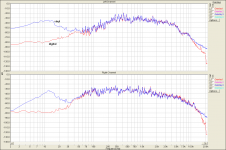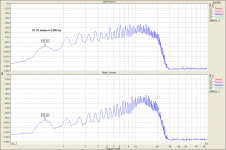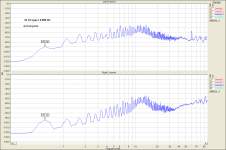There's quite a bit of subsonic noise in the vinyl, around 10-11 Hz - and it peaks at less than 20dB down - presumably the usual TT artifacts. I wonder how much of a difference this would make in some people's systems, because that signal is constantly modulating at least part of the chain?
My analog path is free of hum 😀
I would have expected nothing less 😉
Its been a very interesting listening test. Thanks Pavel.
I've mentioned a couple of times that the sound degraded as it progressed through the vinyl rip, 1.wav, so I just started investigating to see if there is some overall indicator in the waveforms, of something altering. I equalised to brickwall at 10kHz, discarding all lower frequencies of the two versions - because the "funny stuff" usually happens in the treble - and there are some quite distinctive characteristics in the remaining, pure upper treble; the left channel of the vinyl gets busier and busier as it progresses - for the MP3 it remains constant - and, the dynamic range of this part of the spectrum drops off in the right channel of the vinyl, compared to MP3.
At the beginning of the track the two versions are a reasonably good match, at a simple visual level, but the behaviour of the vinyl starts showing a variation fairly soon - is this what I'm hearing? Some more investigation, I think ...
At the beginning of the track the two versions are a reasonably good match, at a simple visual level, but the behaviour of the vinyl starts showing a variation fairly soon - is this what I'm hearing? Some more investigation, I think ...
Last edited:
(P.S.: Audacity is still not the best tool for the reason of limited possibilities of spectrum window setting)
What limits are you thinking of here? The size of the window?
I'used headphones and Foobar.
I started to listen to 1inv first and much disliked it.
I then listened to 1 which I found better, and then a.
Finally I voted for 1.
The more I did comparisons between the three,
jumping from one to another,
the less I could find them different.
I started to listen to 1inv first and much disliked it.
I then listened to 1 which I found better, and then a.
Finally I voted for 1.
The more I did comparisons between the three,
jumping from one to another,
the less I could find them different.
What limits are you thinking of here? The size of the window?
Independent X-axis frequency range setting, averaging, peak-and-hold function as a small example.
It sounds a lot like studio hum to me, typical of the time period. And since I heard it on both, it was pretty clearly not the phono stage. 🙂In Audacity I also noticed the two spikes at 60 and 120Hz but was surprised they were present on both versions. I thought anything like that would have been on the phono stage only. Seems to be on the master though.
Re-sampling files to lower rate improves low frequency resolution with modest sized FFT;
Here are overlays of FR for CD and vinyl versions with conversion to 882Hz sample rate:

Cantilever and tonearm form two conical pendulums connected by cantilever suspension. Mass of tonearm, cartridge, and counterweight bob about tonearm pivot. Every little motion of stylus pumps the tonearm. This is aggravated by tonearm resonance. Tiny offset of LP center hole and snugness of fit to platter spindle pump the tonearm with every revolution of the platter.
Modulation of all the sub sonic garbage with audio band is part of vinyl sound. Result is similar to intermodulation distortion of speaker driver.
When woofer, full range speaker, or headphones are driven with such signals IMD happens.
Here are overlays of FR for CD and vinyl versions with conversion to 882Hz sample rate:

Cantilever and tonearm form two conical pendulums connected by cantilever suspension. Mass of tonearm, cartridge, and counterweight bob about tonearm pivot. Every little motion of stylus pumps the tonearm. This is aggravated by tonearm resonance. Tiny offset of LP center hole and snugness of fit to platter spindle pump the tonearm with every revolution of the platter.
Modulation of all the sub sonic garbage with audio band is part of vinyl sound. Result is similar to intermodulation distortion of speaker driver.
When woofer, full range speaker, or headphones are driven with such signals IMD happens.
Modulation of all the sub sonic garbage with audio band is part of vinyl sound.
Of course, as well as the LF groove noise.
Result is similar to intermodulation distortion of speaker driver.
I am not sure about this
When woofer, full range speaker, or headphones are driven with such signals IMD happens.
I am not sure about this
😉
33 1/3 rpm makes 0,555 Hz 🙂
eccentricity effect
(LP filtered, resampled)
eccentricity effect
(LP filtered, resampled)
Attachments
Last edited:
I've mistaken
Excuse me. I voted "1" but my intention was to vote "a".
I was "only" wrong to press the right key
Excuse me. I voted "1" but my intention was to vote "a".
I was "only" wrong to press the right key
Yes I will, at the end of the test period 🙂
So: What TT/tonearm/cartridge were used for this (we can see the preamp)?
Excuse me. I voted "1" but my intention was to vote "a".
I was "only" wrong to press the right key
Don't worry 😉 its not a mission critical mistake.
Technics SL-1200 MkII, Ortofon 2M Red
I was expecting something more "exotic", especially with such excellent results! 🙂 (Actually I have always been a bit of an Ortofon "fanboy", but I didn't expect their entry-level cart to be so good.)
Due you have test vinyl with pure tone? 10 or 20 seconds with big FFT or sampled down may show IMD side bands.
I started to listen to 1inv first and much disliked it.
I then listened to 1 which I found better
Very very interesting comment 🙂
I was expecting something more "exotic", especially with such excellent results! 🙂 (Actually I have always been a bit of an Ortofon "fanboy", but I didn't expect their entry-level cart to be so good.)
I've heard the 2M Red on Project tables, and it sounds nasty. Maybe that's why I voted for a.wav.
jeff
- Status
- Not open for further replies.
- Home
- General Interest
- Everything Else
- Listening test - do you prefer CD or vinyl version


